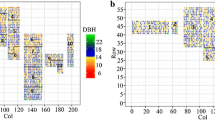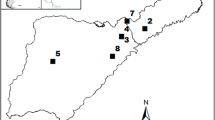Abstract
Single-trial and across-trial spatial analyses using autoregressive error structures were conducted for growth traits based on 1,146 data sets from 275 Douglas-fir [Pseudotsuga menziesii (Mirb.) Franco] progeny trials in 45 first-generation breeding zones in the US Pacific Northwest. The breeding zones encompassed a wide range of latitude, longitude, and elevation. Efficiency of using spatial analysis in reducing variation due to site heterogeneity, estimating genetic parameters, and increasing prediction accuracy was compared among different experimental designs, traits, assessment ages, and tree spacings. More than 97% of the data sets showed significant model improvement with spatial analysis, and height showed more improvement than diameter or volume. Spatial analysis on average removed 14~34% of residual variance due to spatial heterogeneity, which resulted in an up to 20% increase in accuracy of breeding value prediction. The coefficient of variation decreased substantially due to spatial adjustment. Rank correlation between predicted gains before and after spatial analysis was about 0.96, and spatial analysis had little effect on the average predicted gain of the top 20% of parents. We did not observe substantial geographic trends in improvements due to spatial adjustment. Across-site spatial analysis had almost no effect on genotype-by-environment interaction but tended to increase among-trial heterogeneity of residual variance. Two different methods for across-trial spatial analysis were compared and discussed.



Similar content being viewed by others
References
Akaike H (1974) A new look at the statistical model identification. IEEE Trans Automat Contr 19:716–723
Anekonda TS, Libby WJ (1996) Effectiveness of nearest-neighbor data adjustment in a clonal test of redwood. Silvae Genet 45:46–51
Bartlett MS (1978) Nearest neighbour models in the analysis of field experiments. J R Statist Soc B 40:147–174
Bell ST, Mulla DJ, Konzak CF (1993) Spatial heterogeneity affects variety trial interpretation. Crop Sci 33:931–935
Besag J, Kempton R (1986) Statistical analysis of field experiments using neighbouring plots. Biometrics 42:231–251
Braysher BD, Dear BS, Boschma S, Cullis BR, Sandral GA (2001) Improving the efficiency of pasture breeding programs through the use of spatial analysis. Proceedings of Tenth Australian Agronomy Conference, 29 January–1 February. Australian Society of Agronomy, Hobart, Australia
Bresler ES, Dasberg DR, Dagan G (1981) Spatial variability of crop yield as a stochastic process. Soil Sci Soc Am J 45:600–605
Cliff AD, Ord JK (1981) Spatial processes, models and applications. Pion, Landon
Cochran WG, Cox GM (1957) Experimental designs, 2nd edn. Wiley, New York
Costa e Silva J, Dutkowski GW, Gilmour AR (2001) Analysis of early tree height in forest genetic trials is enhanced by including a spatially correlated residual. Can J For Res 31:1887–1893
Costa e Silva J, Dutkowski GW, Borralho NMG (2005) Across-site heterogeneity of genetic and environmental variances in the genetic evaluation of Eucalyptus globulus trials for height growth. Ann For Sci 62:183–191
Cullis BR, Gleeson AC (1989) The efficiency of neighbor analysis for replicated variety trials in Australia. J Agric Sci 113:223–239
Cullis BR, Gleeson AC (1991) Spatial analysis of field experiments—an extension to two dimentions. Biometrics 47:1449–1460
Cullis B, Gogel B, Verbyla A, Thompson R (1998) Spatial analysis of multi-environment early generation variety trials. Biometrics 54:1–18
Dutkowski GW, Costa E Silva J, Gilmour AR, Lopez GA (2002) Spatial analysis methods for forest genetic trials. Can J For Res 32:2201–2214
Dutkowski GW, Wellendorf H, Aguiar A, Silva JC, Gilmour AR (2006) Spatial analysis enhances modelling of a wide variety of traits in forest genetic trials. Can J For Res 36:1851–1870
Falconer DS, Mackay TFC (1996) Introduction to quantitative genetics, 4th edn. Longman, New York
Fox JC, Ades PK, Bi H (2001) Stochastic structure and individual-tree growth models. For Ecol Manag 154:261–276
Fu Y (2003) On implementation of incomplete block designs in forest genetic field trials. For Genet 10:23–33
Fu YB, Clarke GPY, Namkoong G, Yanchuk AD (1998) Incomplete block designs for genetic testing: statistical efficiencies of estimating family means. Can J For Res 28:977–986
Fu YB, Yanchuk AD, Namkoong G (1999) Spatial patterns of tree height variations in a series of Douglas-fir progeny trials: implications for genetic testing. Can J For Res 29:714–723
Gilmour AR, Cullis BR, Verbyla AP (1997) Accounting for natural and extraneous variation in the analysis of field experiments. J Agric Biol Environ Stat 2:269–273
Gilmour AR, Gogel BJ, Cullis BR, Thompson R (2006) ASReml user guide release 2.0. VSN International, Hemel Hempstead, UK
Gleeson AC (1997) Spatial analysis. In: Kempton RA, Fox PN (eds) Statistical methods for plant variety evaluation. Chapman and Hall, London
Green P, Jennison C, Seheult A (1985) Analysis of field experiments by least squares smoothing. J R Statist Soc B 47:299–315
Grondona MO, Crossa J, Fox PN, Pfeiffer WH (1996) Analysis of variety trials using two-dimensional separable ARIMA processes. Biometrics 52:763–770
Hamann A, Namkoong G, Koshy MP (2002) Improving precision of breeding values by removing spatially autocorrelated variation in forestry field experiments. Silvae Genet 51:210–215
Helms TC, Scott RA, Hammond JJ (1999) Intrablock variance among duplicate treatments for nearest-neighbor analysis. Agron J 91:317–320
Henderson CR (1976) Asimple method for computing the inverse of a numerator relationship matrix used in the prediction of breeding values. Biometrics 32:69–83
Hill WG (1984) Selection among groups with heterogeneous variance. Animal production 39:473–477
Howe GT, Jayawickrama KJ, Cherry ML, Wheeler NC, Johnson GR (2005) Breeding Douglas-fir. In: Janick J (ed) Plant breed rev. Wiley, New York, pp 245–353
Jayawickrama KJS, Ye T (2004) Genetic gain predictions for coastal Douglas-fir in the US Pacific Northwest and their relationships with parent tree location. Forest genetics and tree breeding in the age of genomics: progress and future, IUFRO Joint Conference of Division 2, Conference Proceedings, Charleston, South Carolina, pp 204–206
Joyce D, Ford R, Fu YB (2002) Spatial patterns of tree height variations in a black spruce farm-field progeny test and neighbors-adjusted estimations of genetic parameters. Silvae Genet 51:13–18
Kempton RA (1982) Adjustment for competition between varieties in plant breeding trials. J Agric Sci 98:599–611
Kusnandar D, Galwey N (2000) A proposed method for estimation of genetic parameters on forest trees without raising progeny: critical evaluation and refinement. Silvae Genet 49:15–21
Loo-Dinkins JA (1992) Field test design. In: Fins L, Friedman S, Brotschol J (eds) Handbook of quantitative forest genetics. Kluwer, Dordrecht, The Netherlands, pp 96–139
Loo-Dinkins JA, Tauer CG, Lambeth CC (1990) Selection system efficiencies for computer simulated progeny test field designs in loblolly pine. Theor Appl Genet 79:89–96
Lopez MV, Arrue JL (1995) Efficiency of an incomplete block design based on geostatistics for tillage experiments. Soil Sci Soc Am J 59:1104–1111
Lynch M, Walsh B (1998) Genetics and analysis of quantitative traits. Sinauer, Sunderland, MA
Magnussen S (1989) Effects and adjustments for competition bias in progeny trials with single-tree plots. For Sci 35:532–547
Magnussen S (1990) Application and comparison of spatial models in analyzing tree genetics field trials. Can J For Res 20:536–546
Magnussen S (1993) Bias in genetic variance estimates due to spatial autocorrelation. Theor Appl Genet 86:349–355
Magnussen S (1994) A method to adjust simultaneously for spatial microsite and competition effects. Can J For Res 24:985–995
Meyer K (2006) PX × AI: algorithmics for better convergence in restricted maximum likelihood estimation. 8th World Congress on Genetics Applied to Livestock Production, August 13–18, Belo Horizonte, Brasil
Papadakis JS (1937) Méthode statistique pour des expériences sur champ. Institute de Amélioration des Plantes à Salonique Bull. 23
Pearce SC (1980) Randomized blocks and some alternatives: a study in tropical conditions. Trop Agric 57:1–10
Reed DD, Burkhart HE (1985) Spatial autocorrelation of individual tree characteristics in loblolly pine stands. For Sci 31:575–587
Salvador AG, White TL, Huber DA (2006) Comparison of experimental designs for clonal forestry using simulated data. For Sci 52:108–116
Schutz WM, Cockerham CC (1966) The effect of field blocking on gain from selection. Biometrics 22:843–863
Shaw RG (1987) Maximum-likelihood approaches applied to quantitative genetics of natural populations. Evolution 41:812–826
Silen RR, Wheat JG (1979) Progressive tree improvement program in coastal Douglas-fir. J For 77:78–83
Singh M, Malhotra RS, Ceccarelli S, Sarker A, Grando S, Erskine W (2003) Spatial variability models to improve dryland field trials. Exp Agric 39:151–160
Smith HF (1938) Anempirical law describing heterogeneity in the yields of agricultural crops. J Agric Sci 28:1–23
Smith KF, Casler MD (2004) Spatial analysis of forage grass trials across locations, years, and harvests. Crop Sci 44:56–62
Smith A, Cullis B, Thompson R (2001) Analyzing variety by environment data using multiplicative mixed models and adjustments for spatial field trend. Biometrics 57:1138–1147
Stram DO, Lee JW (1994) Variance components testing in the longitudinal mixed effects setting. Biometrics 50:1171–1177
Stroup WW, Baenziger PS, Mulitze DK (1994) Removing spatial variation from wheat yield trials: a comparison of methods. Crop Sci 34:62–66
Upton GJG, Fingleton B (1985) Spatial analysis by example. John, New York
Wilkinson GN, Eckert SR, Hancock TW, Mayo O (1983) Nearest neighbor (NN) analysis of field experiments. J R Statist Soc B 45:151–211
Williams ER, Matheson AC, Harwood CE (2002) Experimental design and analysis for tree improvement, 2nd edn. CSIRO, Collingwood, Australia
Yamada Y (1962) Genotype by environment interaction and genetic correlation of the same trait under different environments. Jpn J Genet 37:498–509
Yang RC, Ye TZ, Blade SF, Bandara M (2004) Efficiency of spatial analyses of field pea variety trials. Crop Sci 44:49–55
Zas R (2006) Iterative kriging for removing spatial autocorrelation in analysis of forest genetic trials. Tree Genet Genomics 2:177–185
Zimmerman DL, Harville DA (1991) A random field approach to the analysis of field-plot experiments and other spatial experiments. Biometrics 47:223–239
Acknowledgments
These progeny data were obtained with great effort and expense by cooperators of the Northwest Tree Improvement Cooperative (NWTIC). Denise Steigerwald imported the data into the NWTIC database. We would like to thank three anonymous reviewers for helpful reviews and comments on the manuscript.
Author information
Authors and Affiliations
Corresponding author
Additional information
Communicated by R. Sederoff
Rights and permissions
About this article
Cite this article
Ye, T.Z., Jayawickrama, K.J.S. Efficiency of using spatial analysis in first-generation coastal Douglas-fir progeny tests in the US Pacific Northwest. Tree Genetics & Genomes 4, 677–692 (2008). https://doi.org/10.1007/s11295-008-0142-4
Received:
Revised:
Accepted:
Published:
Issue Date:
DOI: https://doi.org/10.1007/s11295-008-0142-4




